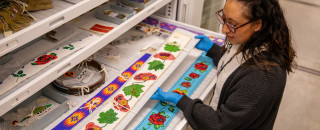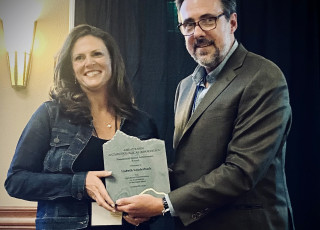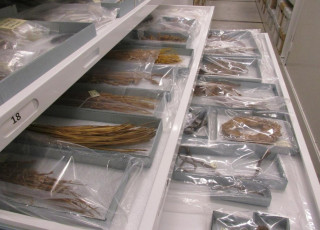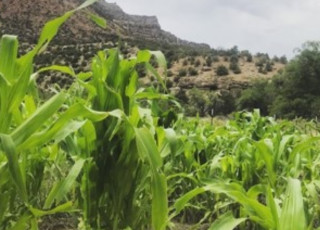NHMU’s Anthropology Collections: What’s in Here & Why
By Olivera Masters
The Natural History Museum of Utah (NHMU) has had the responsibility and privilege of caring for objects detailing the history of the Indigenous people of Utah and specimens of the natural world. NHMU’s mission is to illuminate the natural world and the place of humans within it. NHMU’s collections, which span research fields, are the foundation of this mission. The Museum’s Anthropology Collections documents the region's past and present Indigenous peoples. The Museum has worked with the Indigenous communities in the region, researchers from the University of Utah, and other academic institutions to create the various collections housed at the museum over many years. The Anthropology Collections include over one million objects that tell the stories and history of the Indigenous people of the Intermountain West - from thousands of years ago to today. But what type of objects make up the collections, and more importantly, why are they at the museum?
What type of objects make up the anthropology collections at NHMU?
The Anthropology Collections at NHMU are divided into two main categories: Archaeology and Ethnography. Archaeology is the scientific study of the societies and people of the ancient and recent past through the examination of excavated sites, as well as material remains such as tools, buildings, and other objects. Ethnography is the study of groups of historic and living people and their culture through interviews, consultation, and participant observation and collaboration, and documents cultural diversity and social change through historic and contemporary material objects and art. These objects are an accumulation of woven textiles, basketry, pottery, jewelry, beaded and quilled objects, and more.
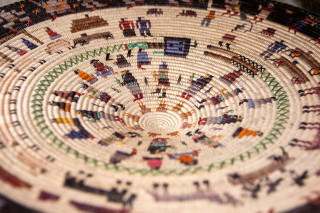
A close up of a pictorial woven basket created by indigenous artist Lorraine Black depicting a Fire Dance. Acc No. UMNH.A.2012. Photo by Eliza Petersen
The Archaeology Collection at NHMU is representative of the material culture – basketry, pottery, and tools made from stone and animal bones - created by the Indigenous people of the Intermountain West before Spanish and Euro-American contact and colonization. The collection is made up of objects collected from archaeological surveys and excavations that have taken place across the Great Basin, Colorado Plateau, and Southwest. Many of the objects in the collection come from the University of Utah’s archaeology excavations, and excavations are still performed by the University’s Range Creek Field Station. Additionally, state and federal archaeologists and contract or cultural resource management archaeologists collect objects that are then reposited at the Museum. NHMU is the state's state and federal lands archaeological repository, which is the working collection of materials gathered during Utah-based archaeological excavations from the past and present. When housed at the museum, the collections staff stabilizes, catalogs, and stores these informative objects. Although archaeological materials are stabilized for long-term storage, many are still the subject of research and study for Indigenous communities and academic researchers. Researchers submit requests to the Collections Manager and Curators for approval prior to studying the collections and are encouraged to consult with Tribal communities. To see archaeological objects at NHMU, visit the third-floor exhibit, First Peoples. This exhibit showcases an assortment of objects from well-known excavation sites in Utah and Arizona that include ancient moccasins, reassembled ceramic vessels, and even a life-size replica of an excavation site you can walk on.
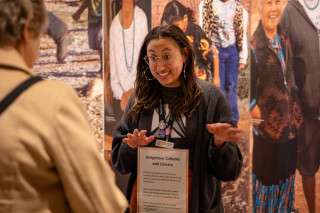
Olivera presents at NHMU’s annual Behind the Scenes event about the role climate plays in indigenous community members’ lives when weaving with wool dyed with plants. Photo by Eliza Petersen
The Ethnographic Collection at NHMU is representative of the material culture created by the Indigenous people of Utah in the last 150 years. The collection focuses primarily on Diné (Navajo), Newe (Shoshone and Goshute – a tribe of Western Shoshone), Nuche (Ute), Nuwuvi (Paiute), and neighboring cultural groups. This portion of the collection is largely made up of objects donated by non-Indigenous collectors who have purchased them from trading posts in the region and directly from Indigenous artists. Additionally, the museum accepts objects into the Ethnographic Collection through donations from or purchases directly from Indigenous artists and consultants. For example, the Anthropology Collections staff selects one or more pieces at NHMU’s annual Indigenous Art Market & Festival for purchase and curation in the Ethnographic Collection. Acquisitions directly from living artists supports a thriving community of contemporary Native artists and supports the museum’s mission to tell the stories of peoples’ places within the natural world. Like the rest of the Anthropology Collections, the Ethnographic Collection is open for study by Indigenous communities at any time and academic researchers upon approved research request. To see examples of ethnographic objects, visit the fifth-floor exhibit, Native Voices. While you are there, experience a one-of-a-kind map of the United States, representations, and descriptions of the five Native groups of Utah, and listen to video and audio recordings of community members in the storytelling circle.
Why are these objects at NHMU?
When properly excavated, the collected objects can tell researchers where people lived and what they ate, wore, and used. Researchers can observe and document how culture has changed -or not- over time and how people have adapted to different geographic locations and shifts in climate. This research can be anything from residue analysis of plants and other organisms to techniques used to make different types of technology to what materials are used for which objects. Research conducted is then published for other scientists to expand upon and used to inform the public. Archaeologists in Utah must be permitted by the state and have curation agreements with institutions like NHMU before proceeding with excavations. The ethnographic collections, too, are researched in many ways by Indigenous community members and academic researchers. These objects help tell the story of Indigenous people, how they have adopted materials from Euro-Americans post-colonization and subsumed them into their own material culture, and how technical and artistic expressions have changed or remained constant through time.
Even more importantly than scientific research, these collections are deeply meaningful to Indigenous communities as a representation of past, present, and future traditions. The anthropology collections have, at times, provided opportunities for Tribal consultants to see and interact with objects that are rarely or no longer constructed. Whether in the form of material types or construction techniques, these interactions with the objects can expand current knowledge of artistic expertise and expression. NHMU is able to administer respectful stewardship of these collections under the direction of the museum’s Indigenous Advisory Committee, Tribal governments, and Federal regulations. Under this direction, the anthropology collections are held in trust to contribute to public and academic knowledge.
Do these objects belong in a museum?
In 1990, the Native American Graves Protection and Repatriation Act (NAGPRA) was passed by Congress to address long-standing concerns over the housing of Native American ancestors, funerary objects, sacred objects, and objects of cultural matrimony/patrimony intentionally excavated or inadvertently discovered on Federal or Federally recognized Tribal land. This law recognizes that these regulations apply to the ancestors and cultural items associated with the Indigenous groups of Alaska, Hawaii, and the continental United States. These ancestors and NAGPRA defined objects that were removed from these lands and belong to these groups require repatriation and disposition back to these communities. As the state repository, the museum holds collections from Federal agencies that are responsible for complying with NAGPRA regulations for reposited collections. NHMU is in compliance with NAGPRA regulations and applicable Utah laws, and repatriations take place per the museum’s legal, fiduciary, and ethical responsibilities. When repositing collections, the museum does not accept collections containing ancestral remains or NAGPRA-related objects, nor does the museum exhibit ancestral remains or cultural belongings associated with burials. NHMU actively consults with Indigenous communities regarding repatriating non-NAGPRA objects to ensure the collections are free of cultural belongings that arrived at the museum historically via unethical means. When accepting donations from collectors, the museum does not accept archaeological or ethnographic objects that lack clear provenience – the documentation of legal ownership and/or origin, or provenance – the modern post-excavation history.
The exhibits have been and continue to be developed through extensive consultation with the Indigenous communities being represented. NHMU works regularly with an Indigenous Advisory Committee to ensure proper management of collections care, exhibit development, and the appropriate representation of Indigenous people and culturally significant topics. The Native Voices Initiative is an ongoing Indigenous collaboration project conducted at NHMU and led by Dr. Alexandra Greenwald, Curator of Ethnography and University of Utah Assistant Professor. This federally funded grant centers on highlighting Native voices in the Anthropology Collections. This project has funded interviews with over 20 consultants from various Tribal affiliations at the museum. These interviews detail consultants’ personal experiences, including their own artistic expertise, the cultural significance of objects, preferred terminology, and requested updates to culturally sensitive collections care. By working with Indigenous communities and consultants on projects like the Native Voices Initiative, the Anthropology Collections team can increase their understanding of objects requiring sensitive care and repatriation.
Additionally, Indigenous consultants have expressed their understanding of collections' benefits for research, especially for Indigenous community members. These relationships then aid in building and maintaining trust between Indigenous communities and the museum. This information, which has been entrusted to NHMU, will impact academic research and Native representation in the museum for a long time to come.
Explore the rich history of Utah’s Native peoples by visiting the Natural History Museum of Utah or virtually explore the collections here.
